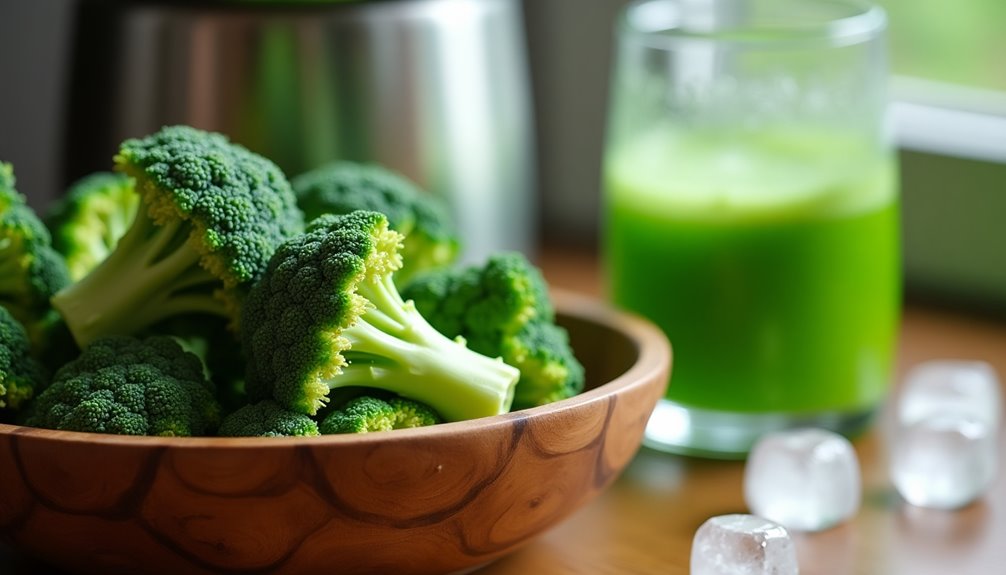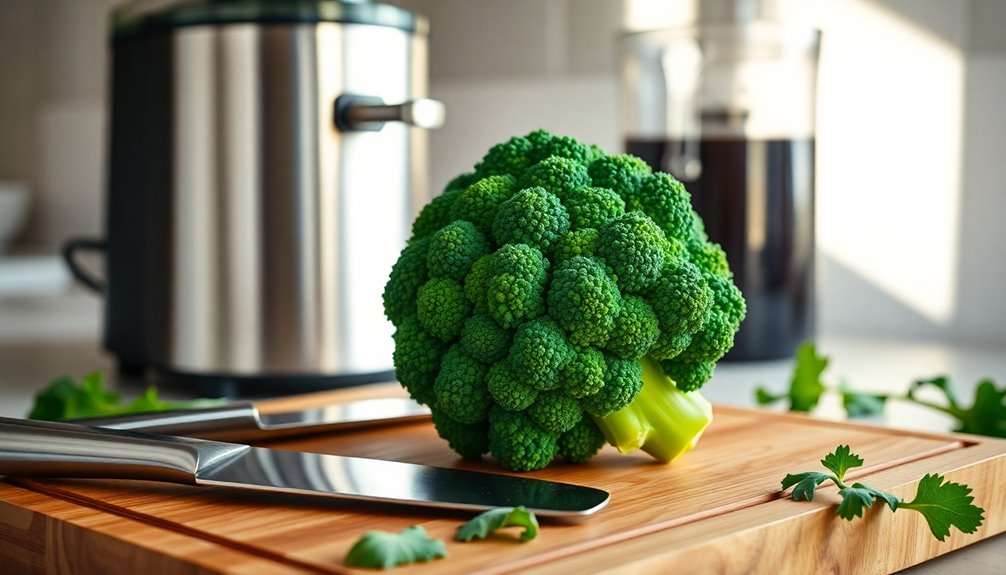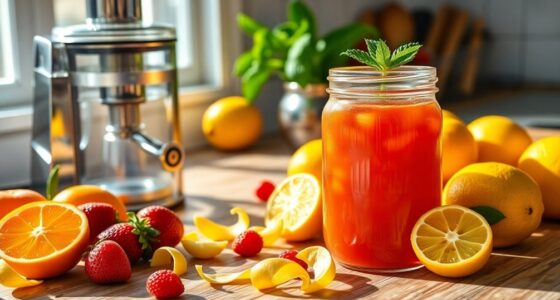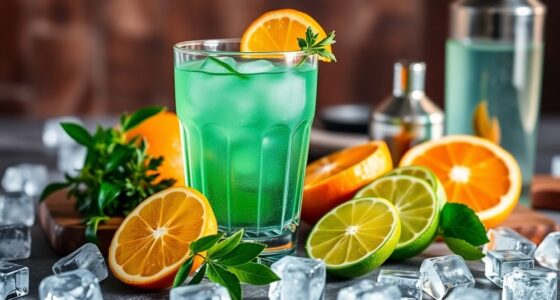Juicing broccoli is easy and rewarding. Start by washing the florets and cutting them into small pieces, including the stems for added nutrients. Blend the pieces with sweeter fruits like green apples or pears for balance. If you want a smoother texture, strain the mixture using a nut milk bag. It's best to drink the juice immediately for maximum benefits, but you can store it in the fridge for up to four days. Discover more tips for a great juice!
Key Takeaways
- Wash broccoli florets and stems thoroughly to remove any dirt and pesticides before juicing.
- Cut broccoli into small pieces to fit your juicer or blender for easier blending.
- Blend the broccoli with optional sweet ingredients like green apples or pears for a balanced flavor.
- Strain the blended mixture using a nut milk bag for a smoother juice texture.
- Consume the juice immediately for optimal nutrient retention, or refrigerate it for up to four days.

Juicing broccoli might seem unconventional, but it's a fantastic way to harness its nutritional benefits. Broccoli is a powerhouse vegetable, packed with vitamins, minerals, and antioxidants. It's an excellent source of vitamin C, which helps boost your immune system and promotes overall health. If you're looking for healthy recipes to incorporate into your diet, this broccoli juice recipe is a great option. Not only does it provide a refreshing drink, but it also delivers a concentrated dose of nutrition.
To start, you'll want to wash your broccoli florets thoroughly. This step is crucial for removing any dirt or pesticides that might linger on the surface. Once clean, cut the broccoli into small pieces that fit your juicer or blender. Don't forget to include the stems! They may yield less juice than the florets, but they still offer valuable nutrients and flavor. By using both parts of the broccoli, you maximize the health benefits.
When it comes to the flavor profile of your broccoli juice, you might find it a bit strong on its own. To create a more balanced taste, consider adding sweeter ingredients like green apples or pear juice. These fruits not only complement the broccoli but also enhance the overall flavor, making it more enjoyable to drink. If you prefer a citrus twist, a splash of lemon juice can brighten the mix and add a zesty kick.
Once you've blended your ingredients, it's time to strain the mixture. Using a nut milk bag is a great way to remove any fibrous materials, resulting in a smoother juice texture. This step is especially important if you're juicing for someone with a feeding tube, as a smooth consistency is easier to consume. Straining also helps to concentrate the flavors, giving you a refreshing drink that's packed with nutrients.
After preparing your juice, it's best to consume it immediately to reap the maximum health benefits. Freshly made juice retains the most nutrients and provides the best flavor. However, if you need to store it, keep it in a covered container in the refrigerator. You can refrigerate your juice for up to four days, but try to drink it as soon as possible to enjoy its freshness.
When you're at the grocery store, keep an eye out for fresh broccoli and the additional fruits you want to include. A well-stocked kitchen makes it easier to whip up this healthy juice whenever you crave it. Additionally, consuming nutrient-rich vegetables like broccoli can significantly contribute to overall health and well-being.
Frequently Asked Questions
Can You Juice Raw Broccoli?
Yes, you can definitely juice raw broccoli! It's packed with vitamins C, K, and folate, making it a nutritious choice.
Just wash the broccoli thoroughly and cut it into small florets to fit in your juicer.
Keep in mind that the taste can be quite strong, so you might want to mix it with sweeter ingredients like cucumber or green apple.
For the best flavor and nutrients, drink it right after juicing!
How to Juice Broccoli Without a Juicer?
Juicing broccoli without a juicer is simple and rewarding.
Start by chopping the florets and stems into small pieces, then blend them with water in a high-speed blender.
Strain the mixture through a nut milk bag or fine mesh sieve, squeezing to get every drop.
Store any leftover juice in a covered container in the fridge, and enjoy your nutritious drink within a few days for maximum freshness and flavor!
Can Broccoli Stems Be Juiced?
Yes, you can juice broccoli stems!
While they might yield a bit less juice than the florets, they're still packed with vitamins and minerals like vitamin C and potassium.
Just cut the stems into smaller pieces to fit them into your juicer.
You'll find that incorporating stems adds a subtle earthiness to your juice, enhancing the overall flavor.
Just make sure the stems are fresh for the best taste and nutrient extraction.
What Is the Best Way to Juice Vegetables?
The best way to juice vegetables is to start with a high-quality juicer that extracts juice efficiently while keeping nutrients intact.
Chop your veggies into small pieces to fit the juicer's feeding tube. Always wash them thoroughly; soaking leafy greens in saltwater helps remove any dirt.
After juicing, strain the juice through a nut milk bag for a smoother texture.
Finally, mix in sweeter or tangy ingredients to enhance the overall flavor.
Conclusion
In the grand symphony of health, broccoli juice plays a vibrant note. Embrace this green elixir, and you'll find yourself dancing in the delightful world of nutrition. By transforming this humble vegetable into a refreshing drink, you're not just sipping on juice; you're savoring a burst of vitality that whispers promises of well-being. So, raise your glass to this verdant treasure, and let each sip serenade your body with its nourishing charm. Cheers to your health!
Cindy thoroughly researches juicing trends, techniques, and recipes to provide readers with practical advice and inspiration. Her writing style is accessible, engaging, and designed to make complex concepts easy to understand. Cindy’s dedication to promoting the advantages of juicing shines through her work, empowering readers to make positive changes in their lives through the simple act of juicing.











